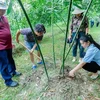 Bat Trang village is one of many ancient traditional craft villages in the country. The village is well-known for the traditional pottery trade. It was said that the people of Bo Bat village (now Yen Thanh commune, the northern province of Ninh Binh), followed King Ly Cong Uan when he moved the capital city from Hoa Lu to Ninh Binh to Thang Long - now Hanoi, in the year 1010. They set up a pottery and brick-making ward on the banks of the Red River, which is now Bat Trang. After hundreds of years, the traditional ceramic village in Gia Lam district, Hanoi, has affirmed its position and brand name in both domestic and foreign markets (Photo: VietnamPlus).
Bat Trang village is one of many ancient traditional craft villages in the country. The village is well-known for the traditional pottery trade. It was said that the people of Bo Bat village (now Yen Thanh commune, the northern province of Ninh Binh), followed King Ly Cong Uan when he moved the capital city from Hoa Lu to Ninh Binh to Thang Long - now Hanoi, in the year 1010. They set up a pottery and brick-making ward on the banks of the Red River, which is now Bat Trang. After hundreds of years, the traditional ceramic village in Gia Lam district, Hanoi, has affirmed its position and brand name in both domestic and foreign markets (Photo: VietnamPlus).  Located in the Gia Lam district of Hanoi, Bat Trang is the only commune in the northern delta region not associated with agriculture. Bat Trang village is famous throughout the country not only for its ceramic-making craft but also for its time-honoured culture, century-old clans and spiritual traditions. Ancient bibliographies and inscriptions also show that Bat Trang village had 364 people who had passed the Confucian exams during feudal times. Of them, eight earned a doctoral degree. In Bat Trang, the relics of communal houses, temples, pagodas and literature documents are still preserved. Bat Trang is a special village as it is home to five types of sacred architecture. (Photo: VietnamPlus)
Located in the Gia Lam district of Hanoi, Bat Trang is the only commune in the northern delta region not associated with agriculture. Bat Trang village is famous throughout the country not only for its ceramic-making craft but also for its time-honoured culture, century-old clans and spiritual traditions. Ancient bibliographies and inscriptions also show that Bat Trang village had 364 people who had passed the Confucian exams during feudal times. Of them, eight earned a doctoral degree. In Bat Trang, the relics of communal houses, temples, pagodas and literature documents are still preserved. Bat Trang is a special village as it is home to five types of sacred architecture. (Photo: VietnamPlus)  Bat Trang is a special village as it is home to five types of sacred architecture. The sacred architecture types are Dinh (a communal house worshipping a village’s tutelary gods), Den (a temple dedicated to gods or revered national heroes), Chua (a Buddhist pagoda), Van Chi (a temple dedicated to Confucius) and Mieu (a shrine dedicated to nature or supernatural figures). Bat Trang’s Van Chi is located behind the village’s communal house. The Van Chi was set up as early as the establishment of the village to worship Confucius, his disciples and local people who had passed the exams held by the feudal regime. (Photo: VietnamPlus)
Bat Trang is a special village as it is home to five types of sacred architecture. The sacred architecture types are Dinh (a communal house worshipping a village’s tutelary gods), Den (a temple dedicated to gods or revered national heroes), Chua (a Buddhist pagoda), Van Chi (a temple dedicated to Confucius) and Mieu (a shrine dedicated to nature or supernatural figures). Bat Trang’s Van Chi is located behind the village’s communal house. The Van Chi was set up as early as the establishment of the village to worship Confucius, his disciples and local people who had passed the exams held by the feudal regime. (Photo: VietnamPlus)  The Van Chi at Bat Trang village is designed in the shape of the Chinese character “Nhi” (meaning "two"), which comprises two parallel buildings. At the front is the Tien Te (Front Ceremonial Hall), and at the back is the Hau Cung (Back Ceremonial Hall). Each building comprises three main chambers and two smaller chambers on two sides. Bat Trang’s Van Chi is located behind the village’s communal house. The Van Chi was set up as early as the establishment of the village to worship Confucius, his disciples and local people who had passed the exams held by the feudal regime. (Photo: VietnamPlus)
The Van Chi at Bat Trang village is designed in the shape of the Chinese character “Nhi” (meaning "two"), which comprises two parallel buildings. At the front is the Tien Te (Front Ceremonial Hall), and at the back is the Hau Cung (Back Ceremonial Hall). Each building comprises three main chambers and two smaller chambers on two sides. Bat Trang’s Van Chi is located behind the village’s communal house. The Van Chi was set up as early as the establishment of the village to worship Confucius, his disciples and local people who had passed the exams held by the feudal regime. (Photo: VietnamPlus)  Ancient bibliographies and inscriptions show that Bat Trang village had 364 people who had passed the royal exams held by feudal regimes in the past. Of them, eight earned a doctoral degree, and one of them was a Valedictorian, gaining the top position in an exam. Those people were also worshipped at the village’s Van Chi, along with Confucius. The Van Chi was set up as early as the establishment of the village to worship Confucius, his disciples and local people who had passed the exams held by the feudal regime. The architecture work is designed in the shape of the Chinese character of “Nhi” (meaning "two"), which comprises two parallel buildings. (Photo: VietnamPlus)
Ancient bibliographies and inscriptions show that Bat Trang village had 364 people who had passed the royal exams held by feudal regimes in the past. Of them, eight earned a doctoral degree, and one of them was a Valedictorian, gaining the top position in an exam. Those people were also worshipped at the village’s Van Chi, along with Confucius. The Van Chi was set up as early as the establishment of the village to worship Confucius, his disciples and local people who had passed the exams held by the feudal regime. The architecture work is designed in the shape of the Chinese character of “Nhi” (meaning "two"), which comprises two parallel buildings. (Photo: VietnamPlus)  One of the symbols placed at the entrance to the Tien Te (Front Ceremonial Hall) of the Van Chi Bat Trang. The Van Chi was set up as early as the establishment of the village to worship Confucius, his disciples and local people who had passed the exams held by the feudal regime. The architecture work is designed in the shape of the Chinese character of “Nhi” (meaning "two"), which comprises two parallel buildings. At the front is the Tien Te (Front Ceremonial Hall), and at the back is the Hau Cung (Back Ceremonial Hall). Each building comprises three main chambers and two smaller chambers on two sides. (Photo: VietnamPlus)
One of the symbols placed at the entrance to the Tien Te (Front Ceremonial Hall) of the Van Chi Bat Trang. The Van Chi was set up as early as the establishment of the village to worship Confucius, his disciples and local people who had passed the exams held by the feudal regime. The architecture work is designed in the shape of the Chinese character of “Nhi” (meaning "two"), which comprises two parallel buildings. At the front is the Tien Te (Front Ceremonial Hall), and at the back is the Hau Cung (Back Ceremonial Hall). Each building comprises three main chambers and two smaller chambers on two sides. (Photo: VietnamPlus)  A visitor takes a photo of an artefact at the Van Chi Bat Trang. Bat Trang commune’s Van Chi is located behind the village’s communal house. The Van Chi was set up as early as the establishment of the village to worship Confucius, his disciples and local people who had passed the exams held by the feudal regime. The architecture work is designed in the shape of the Chinese character of “Nhi” (meaning "two"), which comprises two parallel buildings. At the front is the Tien Te (Front Ceremonial Hall), and at the back is the Hau Cung (Back Ceremonial Hall). Each building comprises three main chambers and two smaller chambers on two sides. (Photo: VietnamPlus)
A visitor takes a photo of an artefact at the Van Chi Bat Trang. Bat Trang commune’s Van Chi is located behind the village’s communal house. The Van Chi was set up as early as the establishment of the village to worship Confucius, his disciples and local people who had passed the exams held by the feudal regime. The architecture work is designed in the shape of the Chinese character of “Nhi” (meaning "two"), which comprises two parallel buildings. At the front is the Tien Te (Front Ceremonial Hall), and at the back is the Hau Cung (Back Ceremonial Hall). Each building comprises three main chambers and two smaller chambers on two sides. (Photo: VietnamPlus)  A decorative object at Van Chi Bat Trang. The Van Chi at Bat Trang commune was recognized as a historical and artistic relic site in 2009, under a decision issued by the People’s Committee of Hanoi, the capital city. Van Chi, which is a temple dedicated to Confucius, is a type of sacred architecture. At the Van Chi Bat Trang, besides Confucius and his disciples, 364 people in the village, who had passed the royal exams held by feudal regimes in the past, are also worshipped here. Of them, eight people had earned a doctoral degree, and one of them was a Valedictorian. The Van Chi was set up as early as the establishment of the village. (Photo: VietnamPlus)
A decorative object at Van Chi Bat Trang. The Van Chi at Bat Trang commune was recognized as a historical and artistic relic site in 2009, under a decision issued by the People’s Committee of Hanoi, the capital city. Van Chi, which is a temple dedicated to Confucius, is a type of sacred architecture. At the Van Chi Bat Trang, besides Confucius and his disciples, 364 people in the village, who had passed the royal exams held by feudal regimes in the past, are also worshipped here. Of them, eight people had earned a doctoral degree, and one of them was a Valedictorian. The Van Chi was set up as early as the establishment of the village. (Photo: VietnamPlus)  The gate of Van Chi Bat Trang. The gate is designed in the style of "Thuong gia ha mon" (meaning that the upper part is a house and the lower part is the gate). It resembles a smaller version of Khue Van Cac (the pavilion of the constellation of literature) in Van Mieu - Quoc Tu Giam (the Temple of Literature in Hanoi). On the main gate, there are three Chinese characters “Nguong Di Cao”, which means "Looking Up Higher". The characters are to remind villagers to always strive to reach higher goals on the path of learning. The Van Chi was set up as early as the establishment of the village to worship Confucius, his disciples and local people who had passed the exams held by the feudal regime. (Photo: VietnamPlus)
The gate of Van Chi Bat Trang. The gate is designed in the style of "Thuong gia ha mon" (meaning that the upper part is a house and the lower part is the gate). It resembles a smaller version of Khue Van Cac (the pavilion of the constellation of literature) in Van Mieu - Quoc Tu Giam (the Temple of Literature in Hanoi). On the main gate, there are three Chinese characters “Nguong Di Cao”, which means "Looking Up Higher". The characters are to remind villagers to always strive to reach higher goals on the path of learning. The Van Chi was set up as early as the establishment of the village to worship Confucius, his disciples and local people who had passed the exams held by the feudal regime. (Photo: VietnamPlus)  The imprint of time can be seen on the gate of the Van Chi Bat Trang. The architecture work was set up as early as the establishment of the village to worship Confucius, his disciples and local people who had passed the exams held by the feudal regime. It is a symbol of the tradition of learning in the village. Ancient bibliographies and inscriptions show that Bat Trang village had 364 people who passed the royal exams held by feudal regimes in the past. Of them, eight people had earned a doctoral degree, and one of them was a Valedictorian, gaining the top position in an exam. (Photo: VietnamPlus)
The imprint of time can be seen on the gate of the Van Chi Bat Trang. The architecture work was set up as early as the establishment of the village to worship Confucius, his disciples and local people who had passed the exams held by the feudal regime. It is a symbol of the tradition of learning in the village. Ancient bibliographies and inscriptions show that Bat Trang village had 364 people who passed the royal exams held by feudal regimes in the past. Of them, eight people had earned a doctoral degree, and one of them was a Valedictorian, gaining the top position in an exam. (Photo: VietnamPlus)  The old tile roof of houses in Bat Trang village. The village has a long history, which dates back around a thousand years. In 1010, King Ly Thai To moved the capital city from Hoa Lu (Ninh Binh) to Thang Long (now Hanoi). Attracted by the development demand of the new capital city, many traders and craft men from all corners of the country flocked to Thang Long. It was said that some craftsmen of the Bo Bat pottery-making village (now Yen Thanh commune, the northern province of Ninh Binh) also moved to Thang Long. They then set up a pottery and brick-making ward on the banks of the Red River, which is now Bat Trang. (Photo: VietnamPlus)
The old tile roof of houses in Bat Trang village. The village has a long history, which dates back around a thousand years. In 1010, King Ly Thai To moved the capital city from Hoa Lu (Ninh Binh) to Thang Long (now Hanoi). Attracted by the development demand of the new capital city, many traders and craft men from all corners of the country flocked to Thang Long. It was said that some craftsmen of the Bo Bat pottery-making village (now Yen Thanh commune, the northern province of Ninh Binh) also moved to Thang Long. They then set up a pottery and brick-making ward on the banks of the Red River, which is now Bat Trang. (Photo: VietnamPlus)  The old tile roof of houses in Bat Trang village. The village has a long history, which dates back around a thousand years. In 1010, King Ly Thai To moved the capital city from Hoa Lu (Ninh Binh) to Thang Long (now Hanoi). Attracted by the development demand of the new capital city, many traders and craft men from all corners of the country flocked to Thang Long. It was said that some craftsmen of the Bo Bat pottery-making village (now Yen Thanh commune, the northern province of Ninh Binh) also moved to Thang Long. They then set up a pottery and brick-making ward on the banks of the Red River, which is now Bat Trang. (Photo: VietnamPlus)
The old tile roof of houses in Bat Trang village. The village has a long history, which dates back around a thousand years. In 1010, King Ly Thai To moved the capital city from Hoa Lu (Ninh Binh) to Thang Long (now Hanoi). Attracted by the development demand of the new capital city, many traders and craft men from all corners of the country flocked to Thang Long. It was said that some craftsmen of the Bo Bat pottery-making village (now Yen Thanh commune, the northern province of Ninh Binh) also moved to Thang Long. They then set up a pottery and brick-making ward on the banks of the Red River, which is now Bat Trang. (Photo: VietnamPlus)  The gate of an old house in Bat Trang village. Several old houses are still preserved in the locality, which has a long history. The first residents of Bat Trang were said to come from Bo Bat pottery-making village in northern Ninh Binh province, who joined the flow of migrants to Thang Long (now Hanoi), after King Ly Thai To moved the capital city from Hoa Lu (Ninh Binh) to Thang Long in 1010. The pottery makers from Bo Bat, together with the local Nguyen family, set up a pottery-making ward on the Red River banks, named Bach Tho (White Clay) ward. (Photo: VietnamPlus)
The gate of an old house in Bat Trang village. Several old houses are still preserved in the locality, which has a long history. The first residents of Bat Trang were said to come from Bo Bat pottery-making village in northern Ninh Binh province, who joined the flow of migrants to Thang Long (now Hanoi), after King Ly Thai To moved the capital city from Hoa Lu (Ninh Binh) to Thang Long in 1010. The pottery makers from Bo Bat, together with the local Nguyen family, set up a pottery-making ward on the Red River banks, named Bach Tho (White Clay) ward. (Photo: VietnamPlus)  Moss covers the old wall around the village. Bat Trang has a long history. The first residents of the village were said to come from Bo Bat pottery-making village in Ninh Binh, who joined the flow of migrants to Thang Long (now Hanoi) after King Ly Thai To moved the capital city from Hoa Lu (Ninh Binh) to Thang Long in 1010. The pottery makers from Bo Bat, together with the local Nguyen family, set up a pottery-making ward on the Red River banks, named Bach Tho (White Clay) ward. The genealogies of some families in Bat Trang, such as the Le, Vuong, Pham and Nguyen, said their ancestors moved here from Bo Bat. (Photo: VietnamPlus)
Moss covers the old wall around the village. Bat Trang has a long history. The first residents of the village were said to come from Bo Bat pottery-making village in Ninh Binh, who joined the flow of migrants to Thang Long (now Hanoi) after King Ly Thai To moved the capital city from Hoa Lu (Ninh Binh) to Thang Long in 1010. The pottery makers from Bo Bat, together with the local Nguyen family, set up a pottery-making ward on the Red River banks, named Bach Tho (White Clay) ward. The genealogies of some families in Bat Trang, such as the Le, Vuong, Pham and Nguyen, said their ancestors moved here from Bo Bat. (Photo: VietnamPlus)  Some walls in Bat Trang are so old that even an entire 'ecology' has formed and grown on them. The first residents of the village were said to come from Bo Bat pottery-making village in Ninh Binh, who joined the flow of migrants to Thang Long (now Hanoi) after King Ly Thai To moved the capital city from Hoa Lu (Ninh Binh) to Thang Long in 1010. In the past, Bo Bat was the combined name, short for Bo Xuyen and Bach Bat communes in Bach Bat district, Yen Mo district of Thanh Hoa, where residents engaged in pottery making since old times. But now Bo Bat belongs to Ninh Binh province. (Photo: VietnamPlus)
Some walls in Bat Trang are so old that even an entire 'ecology' has formed and grown on them. The first residents of the village were said to come from Bo Bat pottery-making village in Ninh Binh, who joined the flow of migrants to Thang Long (now Hanoi) after King Ly Thai To moved the capital city from Hoa Lu (Ninh Binh) to Thang Long in 1010. In the past, Bo Bat was the combined name, short for Bo Xuyen and Bach Bat communes in Bach Bat district, Yen Mo district of Thanh Hoa, where residents engaged in pottery making since old times. But now Bo Bat belongs to Ninh Binh province. (Photo: VietnamPlus)  Small and winding paths between high walls are distinctive features of Bat Trang village. Bat Trang village is famous throughout the country not only for its ceramic-making craft but also for its time-honoured culture, century-old clans and spiritual traditions. Although no historical records have been found to confirm the formation of Bat Trang village, it is believed that it could date back to a thousand years ago. The first residents of the village were said to come from Bo Bat pottery-making village in Ninh Binh, who joined the flow of migrants to Thang Long (now Hanoi) after King Ly Thai To moved the capital city from Hoa Lu (Ninh Binh) to Thang Long in 1010. (Photo: VietnamPlus)
Small and winding paths between high walls are distinctive features of Bat Trang village. Bat Trang village is famous throughout the country not only for its ceramic-making craft but also for its time-honoured culture, century-old clans and spiritual traditions. Although no historical records have been found to confirm the formation of Bat Trang village, it is believed that it could date back to a thousand years ago. The first residents of the village were said to come from Bo Bat pottery-making village in Ninh Binh, who joined the flow of migrants to Thang Long (now Hanoi) after King Ly Thai To moved the capital city from Hoa Lu (Ninh Binh) to Thang Long in 1010. (Photo: VietnamPlus)  Narrow alleyways are a 'speciality' at the Bat Trang craft village. Although no historical records have been found to confirm the formation of Bat Trang village, it is believed that it could date back to a thousand years ago. The genealogies of some families in Bat Trang, such as the Le, Vuong, Pham and Nguyen, said their ancestors moved here from Bo Bat pottery-making village in the northern province Ninh Binh, who joined the flow of migrants to Thang Long (now Hanoi) after King Ly Thai To moved the capital city from Hoa Lu (Ninh Binh) to Thang Long in 1010. (Photo: VietnamPlus)
Narrow alleyways are a 'speciality' at the Bat Trang craft village. Although no historical records have been found to confirm the formation of Bat Trang village, it is believed that it could date back to a thousand years ago. The genealogies of some families in Bat Trang, such as the Le, Vuong, Pham and Nguyen, said their ancestors moved here from Bo Bat pottery-making village in the northern province Ninh Binh, who joined the flow of migrants to Thang Long (now Hanoi) after King Ly Thai To moved the capital city from Hoa Lu (Ninh Binh) to Thang Long in 1010. (Photo: VietnamPlus)  The ancient village of Bat Trang has become a favourite destination for travellers to experience and explore the beauty of old Vietnamese villages. Located in the Gia Lam district of Hanoi, Bat Trang is a special village and is the only commune in the northern delta region not associated with agriculture. Bat Trang village is famous throughout the country not only for its ceramic-making craft but also for its time-honoured culture, century-old clans and spiritual traditions. Although no historical records have been found to confirm the formation of Bat Trang village, it is believed that it could date back to a thousand years ago. (Photo: VietnamPlus)
The ancient village of Bat Trang has become a favourite destination for travellers to experience and explore the beauty of old Vietnamese villages. Located in the Gia Lam district of Hanoi, Bat Trang is a special village and is the only commune in the northern delta region not associated with agriculture. Bat Trang village is famous throughout the country not only for its ceramic-making craft but also for its time-honoured culture, century-old clans and spiritual traditions. Although no historical records have been found to confirm the formation of Bat Trang village, it is believed that it could date back to a thousand years ago. (Photo: VietnamPlus)  Old walls with traces of time in Bat Trang, a special village in the Red River delta. Located in Gia Lam district of Hanoi, Bat Trang is the only commune in the northern delta region not associated with agriculture. Bat Trang village is famous throughout the country not only for its ceramic-making craft but also for its time-honoured culture, century-old clans and spiritual traditions. Although no historical records have been found to confirm the formation of Bat Trang village, it is believed that it could date back a thousand years ago. The ancient village of Bat Trang has become a favourite destination for travellers who love to experience and explore the beauty of old Vietnamese villages. (Photo: VietnamPlus)
Old walls with traces of time in Bat Trang, a special village in the Red River delta. Located in Gia Lam district of Hanoi, Bat Trang is the only commune in the northern delta region not associated with agriculture. Bat Trang village is famous throughout the country not only for its ceramic-making craft but also for its time-honoured culture, century-old clans and spiritual traditions. Although no historical records have been found to confirm the formation of Bat Trang village, it is believed that it could date back a thousand years ago. The ancient village of Bat Trang has become a favourite destination for travellers who love to experience and explore the beauty of old Vietnamese villages. (Photo: VietnamPlus)  An old gate of a house in Bat Trang village. Although no historical records have been found to confirm the formation of Bat Trang village, it is believed that it could date back to a thousand years ago. The ancient village of Bat Trang has become a favourite destination for travellers to experience and explore the beauty of Vietnamese old villages. Located in Gia Lam district of Hanoi, Bat Trang is the only commune in the northern delta region not associated with agriculture. Bat Trang village is famous throughout the country, not only for its ceramic-making craft, but also for its time-honoured culture, century-old clans and spiritual traditions. (Photo: VietnamPlus)
An old gate of a house in Bat Trang village. Although no historical records have been found to confirm the formation of Bat Trang village, it is believed that it could date back to a thousand years ago. The ancient village of Bat Trang has become a favourite destination for travellers to experience and explore the beauty of Vietnamese old villages. Located in Gia Lam district of Hanoi, Bat Trang is the only commune in the northern delta region not associated with agriculture. Bat Trang village is famous throughout the country, not only for its ceramic-making craft, but also for its time-honoured culture, century-old clans and spiritual traditions. (Photo: VietnamPlus)  In the past, villagers used to attach wet coal to the walls for drying before using them in kilns. Located in Gia Lam district of Hanoi, Bat Trang is the only commune in the northern delta region not associated with agriculture. The village has engaged in ceramic making for hundreds of years and Bat Trang ceramics are the pride of Hanoi. Villagers used to use coal as a fuel for their ceramic kilns, but now most have switched to gas tunnel kilns to reduce environmental pollution. When Bat Trang commune was officially recognised as a tourist site, along with old traditional houses and ceramic showrooms, the old kilns became tourist attractions. (Photo: VietnamPlus)
In the past, villagers used to attach wet coal to the walls for drying before using them in kilns. Located in Gia Lam district of Hanoi, Bat Trang is the only commune in the northern delta region not associated with agriculture. The village has engaged in ceramic making for hundreds of years and Bat Trang ceramics are the pride of Hanoi. Villagers used to use coal as a fuel for their ceramic kilns, but now most have switched to gas tunnel kilns to reduce environmental pollution. When Bat Trang commune was officially recognised as a tourist site, along with old traditional houses and ceramic showrooms, the old kilns became tourist attractions. (Photo: VietnamPlus)  A guide directing the way to an old house and eco-tourism site in Bat Trang village. Besides the traditional ceramic-making profession, Bat Trang villagers have found ways to make good use of their cultural heritage. Many families now also engage in community tourism. In recent years, tourists have flocked to Bat Trang to look for traditional artefacts and buy ceramic wares. People also come to make pottery and go sightseeing. In 2011, the municipal People’s Committee approved a detailed plan to preserve and develop the craft village in connection with tourism development. In recent years, the village has greeted over 10,000 international tourists and more than 50,000 Vietnamese tourists per year. (Photo: VietnamPlus)
A guide directing the way to an old house and eco-tourism site in Bat Trang village. Besides the traditional ceramic-making profession, Bat Trang villagers have found ways to make good use of their cultural heritage. Many families now also engage in community tourism. In recent years, tourists have flocked to Bat Trang to look for traditional artefacts and buy ceramic wares. People also come to make pottery and go sightseeing. In 2011, the municipal People’s Committee approved a detailed plan to preserve and develop the craft village in connection with tourism development. In recent years, the village has greeted over 10,000 international tourists and more than 50,000 Vietnamese tourists per year. (Photo: VietnamPlus)  A traditional living space in Bat Trang village. Aware of the local attraction to tourism, which is a traditional way of life, many families have restored and preserved the traditional living space. There are many places to visit in Bat Trang, including old houses like the one owned by artisan To Thanh Son, Tieu Dao Pagoda, Bo Bat old kiln, Kim Truc Pagoda, Giang Cao Temple and Mother Goddesses Temple. Apart from these relics, the core of the Bat Trang commune is 23 traditional houses, 16 family temples and many old kilns, all built with Bat Trang bricks. People flock to the village not only to buy ceramics but also to admire the beautiful scenery and the locality’s rich cultural tradition. (Photo: VietnamPlus)
A traditional living space in Bat Trang village. Aware of the local attraction to tourism, which is a traditional way of life, many families have restored and preserved the traditional living space. There are many places to visit in Bat Trang, including old houses like the one owned by artisan To Thanh Son, Tieu Dao Pagoda, Bo Bat old kiln, Kim Truc Pagoda, Giang Cao Temple and Mother Goddesses Temple. Apart from these relics, the core of the Bat Trang commune is 23 traditional houses, 16 family temples and many old kilns, all built with Bat Trang bricks. People flock to the village not only to buy ceramics but also to admire the beautiful scenery and the locality’s rich cultural tradition. (Photo: VietnamPlus)  A ceramic objects in the making. While most ceramic-making households in Bat Trang have switched to industrial-scale production, several craftsmen persist in the traditional handmade style. Bat Trang ceramic products have been highly appreciated for their quality, designs and categories, divided into functional groups such as household ceramics, worship items, fine pottery artworks, building ceramics and decorative ceramics. The items are sold all over Vietnam and exported to many other countries. Generations in Bat Trang Village have tried to keep their traditional craft and quintessence to create unique and sophisticated products. The village is one of the most thriving craft villages in Hanoi, with about 700 households engaging in pottery making. (Photo: VietnamPlus)
A ceramic objects in the making. While most ceramic-making households in Bat Trang have switched to industrial-scale production, several craftsmen persist in the traditional handmade style. Bat Trang ceramic products have been highly appreciated for their quality, designs and categories, divided into functional groups such as household ceramics, worship items, fine pottery artworks, building ceramics and decorative ceramics. The items are sold all over Vietnam and exported to many other countries. Generations in Bat Trang Village have tried to keep their traditional craft and quintessence to create unique and sophisticated products. The village is one of the most thriving craft villages in Hanoi, with about 700 households engaging in pottery making. (Photo: VietnamPlus)  A worker at a ceramic workshop in Bat Trang. There are approximately 200 enterprises and 1,000 households that produce and trade ceramic wares in the village, with the products sold all over the country and exported to countries like Japan, the Republic of Korea, Thailand, Russia, Italy, and France. The COVID-19 pandemic, which started in early 2020, caused serious negative impacts on the local profession. Production activities were stalled many times, and for a long time, due to lockdowns. However, local ceramic artisans and production facilities have tried hard to maintain their operations. To increase their competitiveness, many small businesses are improving their designs and product quality and learning how to market their products online. (Photo: VietnamPlus)
A worker at a ceramic workshop in Bat Trang. There are approximately 200 enterprises and 1,000 households that produce and trade ceramic wares in the village, with the products sold all over the country and exported to countries like Japan, the Republic of Korea, Thailand, Russia, Italy, and France. The COVID-19 pandemic, which started in early 2020, caused serious negative impacts on the local profession. Production activities were stalled many times, and for a long time, due to lockdowns. However, local ceramic artisans and production facilities have tried hard to maintain their operations. To increase their competitiveness, many small businesses are improving their designs and product quality and learning how to market their products online. (Photo: VietnamPlus)  A visitor at an old house in Bat Trang. The ancient ceramic-making village still preserves traditional houses in the northern delta style, which have become a favourite spot for young people. Aware of the local attraction to tourism which is the traditional way of life, many families have restored and preserved the traditional living space. There are many places to visit in Bat Trang, including old houses like the one owned by artisan To Thanh Son, Tieu Dao Pagoda, Bo Bat old kiln, Kim Truc Pagoda, Giang Cao Temple and Mother Goddesses Temple. Apart from these relics, the core of the Bat Trang commune is 23 traditional houses, 16 family temples and many old kilns, all built with Bat Trang bricks. (Photo: VietnamPlus)
A visitor at an old house in Bat Trang. The ancient ceramic-making village still preserves traditional houses in the northern delta style, which have become a favourite spot for young people. Aware of the local attraction to tourism which is the traditional way of life, many families have restored and preserved the traditional living space. There are many places to visit in Bat Trang, including old houses like the one owned by artisan To Thanh Son, Tieu Dao Pagoda, Bo Bat old kiln, Kim Truc Pagoda, Giang Cao Temple and Mother Goddesses Temple. Apart from these relics, the core of the Bat Trang commune is 23 traditional houses, 16 family temples and many old kilns, all built with Bat Trang bricks. (Photo: VietnamPlus) VNA



















